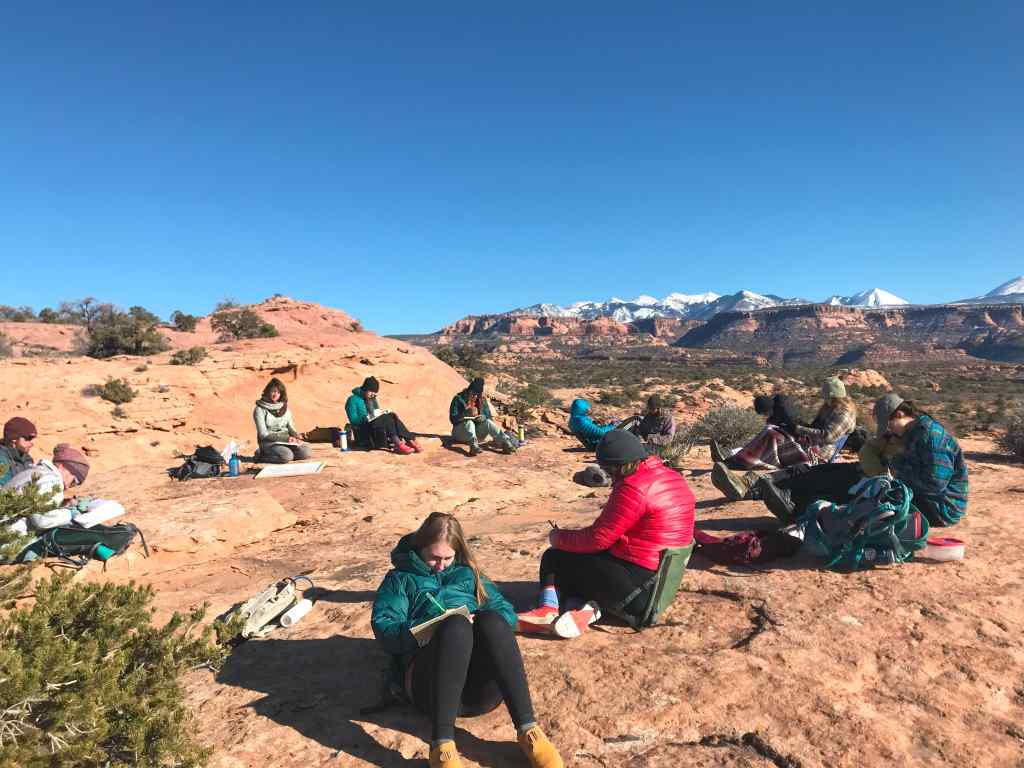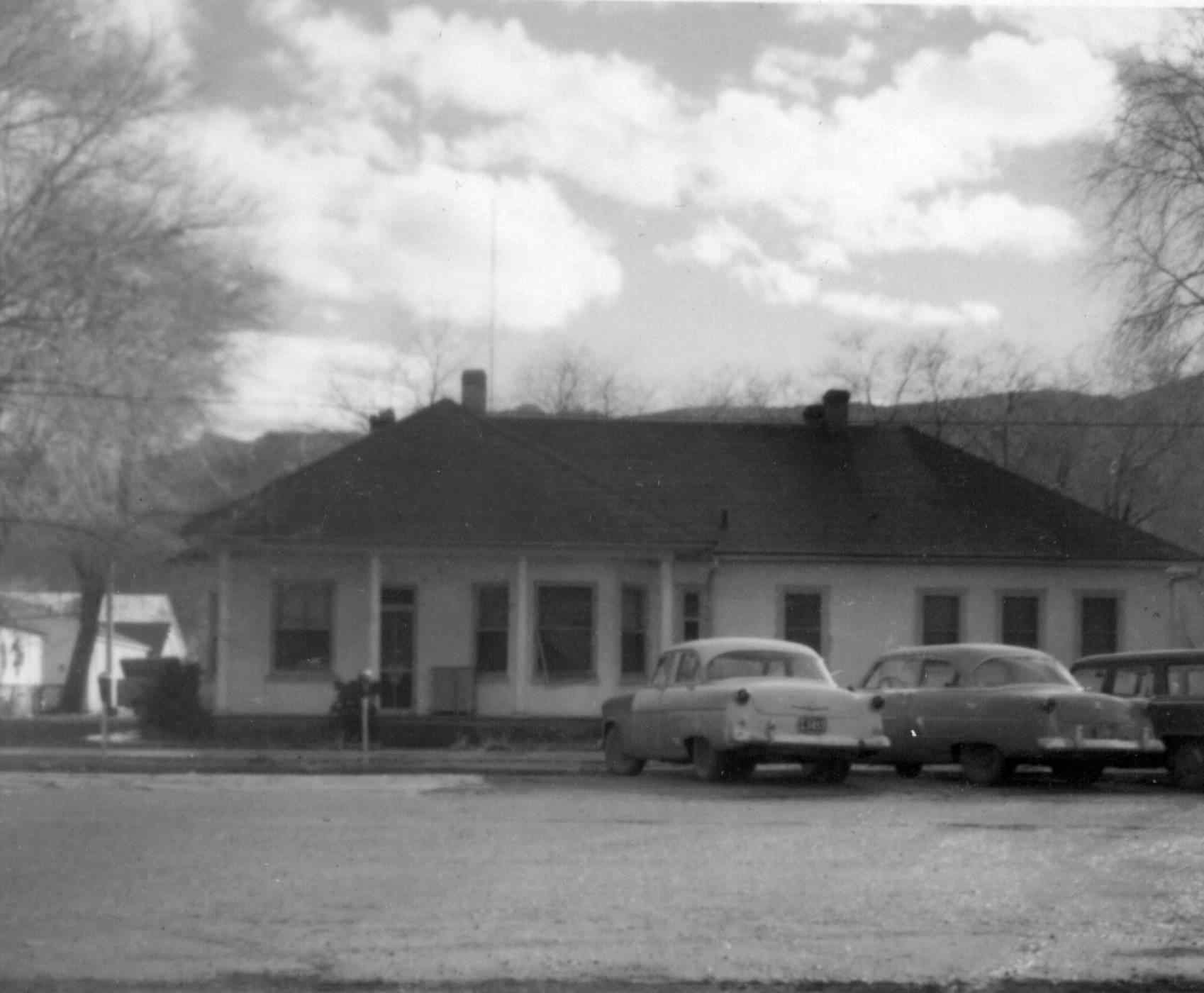After years of uncertainty, Navtec pivoted from Alternative Dwelling Overlay
Seasonal employees at Navtec, one of Moab’s longest-running guide companies, have a new option for housing: a 5,200 square-foot bunkhouse in La Sal with 11 shared bedrooms and space for RVs and camping outside.
Navtec manager Brian Martinez discusses Grand County’s Alternative Dwelling Ordinance in front of the recently opened Navtec employee bunkhouse in La Sal. [Rachel Fixsen/Moab Sun News]
Navtec manager Brian Martinez had hoped to participate in the pilot program of Grand County’s new Alternative Dwelling Ordinance, converting a property owned by Navtec founder John Williams into an established, code-compliant long-term camping area. After a year of research and application extensions, Martinez realized the costs and complexities of bringing the parcel up to the new standards were too much.
“In the end, it just didn’t work,” he said.
The Swamp and the bunkhouse
In years past, many Navtec employees camped in tents, cars, trailers and RVs on Williams’ property in Moab, a place near the waste treatment plant and the Scott and Norma Matheson Wetlands Preserve known as “the Swamp.”
In 2022, after Grand County had clarified a prohibition on camping anywhere outside of designated campgrounds in its boundaries, county code enforcement officers received complaints about campers on the parcel. Residents there were issued a notice and given 30 days to come into compliance—that is, to stop camping at the Swamp.
That notice galvanized Navtec employees and other local workers, who spoke up at county workshops, saying they felt unvalued and had nowhere to go.
County commissioners and planning staff started working on what would come to be called the Alternative Dwelling Ordinance, which passed in 2022. It codified unconventional dwellings like RVs, vans, tents and tiny homes for long-term residence.
Alternative Dwelling Ordinance
Planning and county commissioners spent months hashing out the minutiae of the ordinance, wanting to make it doable for developers but also safe, sanitary and dignified for residents. They also considered carefully how to ensure that the ordinance would be restricted to long-term residents locally employed and not used as overnight rentals.
The Navtec bunkhouse in La Sal. [Rachel Fixsen/Moab Sun News]
The final ordinance outlines requirements for water, sewer, and kitchen areas, as well as for setbacks, parking, lot size and landscaping.
Another point of lengthy discussion was how to determine areas where alternative dwelling developments are appropriate. Officials weighed considerations such as compatibility with existing land uses and neighborhoods, traffic impact, and commute time for employees. Each application was considered by the county commission.
“Alternative dwellings, while part of the Grand County economy and tradition, are not appropriate in all areas of the County,” the Land Use Code reads in section 4.9.
Martinez attended meetings of the Planning Commission and the County Commission to give input on shaping the ordinance. He felt, though, like he had to tread carefully—if he flat-out said a requirement being drafted wouldn’t be feasible, he worried that would jeopardize the extension that allowed his crew to stay on the property while bringing it into compliance.
Compliance
Once the Alternative Dwelling Ordinance was approved, Martinez applied. The research needed to sketch out the development design was daunting.
“I’m a river guide, I’m not a developer,” he said.
Discussion at an April 22 Planning Commission meeting about a different ADO project illustrated the complexities of developing alternative housing units. The Tejada ADO project proposes to add nine ADO units for employees of local guide company Sherri Griffith.
Grand County Planning Director Elissa Martin explained to planning commissioners that the applicant was requesting a six-month extension for their site plan approval for adjustments like adding a bathhouse instead of having residents use existing bathrooms on the property; adding a fence; and bringing water and power to each site. The changes mean the site plan must be reviewed and approved again.
“It’s a little tedious, administrative kind of stuff, but we have to go through it,” Martin said at the meeting.
As Martinez looked into improving the Swamp to meet ADO standards, the costs piled up. The property needed water and sewer; sewage would have had to be pumped uphill. Just the impact fees would have been $80,000, Martinez said.
The property is also in a floodplain, which means it’s subject to certain development restrictions, some of which conflict with ADO requirements.
Before the compliance notice, Swamp residents used portable toilets for sewage and trucked in potable water in tanks. They had access to showers at the Navtec office.
The property does flood each spring, according to Martinez: each year, before annual floods inundated the property, Navtec temporarily moved the portable toilet and campers moved their sites until the floods receded. The permanent infrastructure required by the ADO would have been susceptible to flood damage.
Tallying up various costs, Martinez estimated that bringing the Swamp into compliance with the ADO would have been about $400,000.
“The restrictions that are there are very complex,” he said. That complexity, designed to ensure the safety and dignity of occupants of alternative housing, means the process of developing these kinds of long-term residences takes more time.
“It doesn’t address that we need housing now,” Martinez said.
Realizing they wouldn’t be able to bring the Swamp into compliance, Martinez started looking for property in La Sal, which is in San Juan County. He noticed the bunkhouse property while looking at the parcel next to it. He bought it for about $500,000 and spent about $50,000 on renovations. Some Navtec employees who normally work only in the summer made winter income by helping with the construction.
“We could have bought a whole new rental fleet,” Martinez said, but he decided to invest in housing for employees.
La Sal is about 30 miles south of Moab. The new Navtec bunkhouse has two stories and a wrap-around porch; it sits on six acres and has few close neighbors.
On a weekday in May, there aren’t many people at home: two or three people lounge in their rooms or browse in the kitchen, looking relaxed. A long table in the living room offers seating for a crowd. A total of 11 bedrooms and several bathrooms are down the hall and downstairs. Outside, the porch looks out over the snowy La Sal Mountains; there’s a firepit out back, and one of the employees has installed a chicken coop and is raising chicks. A Navtec van is available for employees to commute to and from Moab.
The Navtec bunkhouse in La Sal. [Rachel Fixsen/Moab Sun News]
Martinez said Navtec has between 50 and 60 employees, both seasonal and year-round. Some have houses and families, others come to the area just for the summer and spend days at a time on the river. Over 20 of them are living in the bunkhouse now. Occupants of the Swamp vacated the property this spring.
While the house in La Sal appears to be a good solution for Navtec employee housing, Martinez is still frustrated after his experience with the alternative dwelling ordinance—so much so that he’s running for county commission this fall.
“Here’s the crux of the problem: if you enforce something without people having options—that’s cruel,” he said.
In the meantime, Martinez says Navtec seasonals are relieved to have a sure place to land.
“They’re pretty happy up here,” he said. “They’ve been kicked a lot—right now they’re like, ‘we’ve got it good.’ And they deserve it.”



